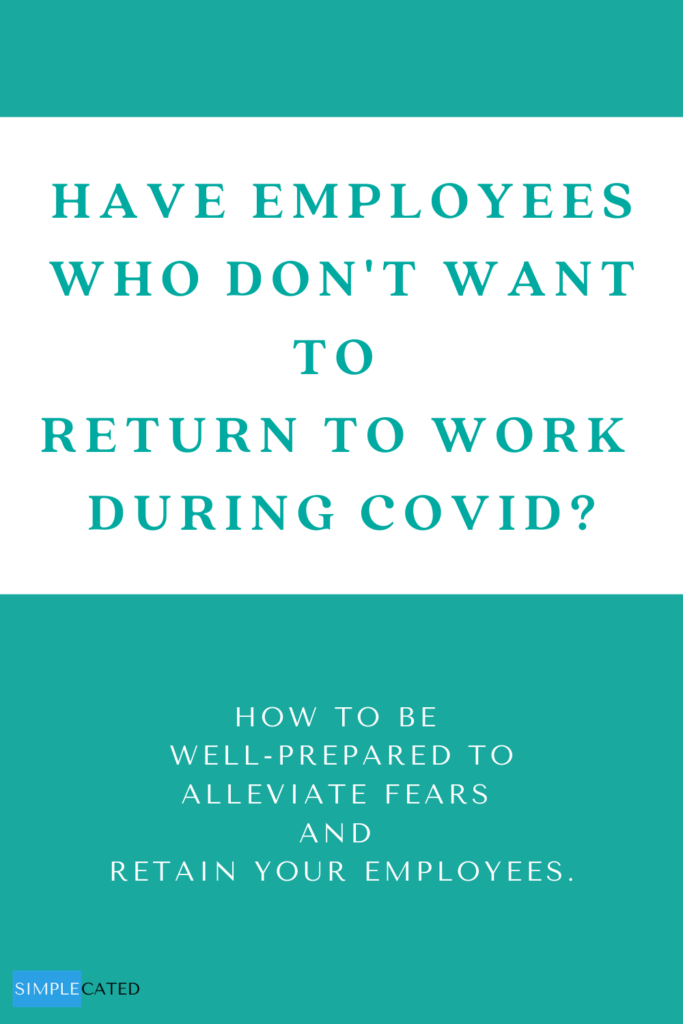Here in Georgia, there’s a lot of attention on our state right now as we’ve started reopening. Some businesses were allowed to reopen last week, and restaurants are now allowed to reopen. It’s not “business as usual,” though. For businesses that do choose to reopen, there is a list of guidelines they are required to follow in response to COVID-19.
For those who decide to reopen, staffing is an obvious necessity. With many people not comfortable being around others, there’s a good chance some of your employees feel the same way. What should you do if your employees don’t want to return to work onsite? You understand why they’re nervous (you may be too), but you also have a business to run.
Communicate your policies and preparedness. Before you reopen, talk with your employees. Explain the reasons you can (and should) reopen, and let your employees know the guidelines that will be required. For example, there may be new policies for social distancing, cleaning, and wearing masks. Also, let your employees know if temperature checks will be required. The Equal Employment Opportunity Commission (EEOC) released guidance on April 23 allowing employers to screen for COVID-19, and it also outlined that employers can require employees with COVID-19 symptoms to remain home. Determine what screening is necessary or required for your business, and let your employees know the process. Proactively communicating can help address concerns your employees may have.
Make sure employees understand they are expected to remain home if they’re sick. Provide paid sick leave through the FFCRA and/or your company policies.
Do your best to be prepared. In addition to any required safety precautions, think about any additional equipment or safety measures that would be meaningful to your employees. Would they appreciate being supplied with masks and gloves? Do workstations or break rooms need to be reconfigured? Share your plans with your employees, and ask for their feedback and suggestions as well. Involving them in the discussion can help to gain their buy-in and lead to a better chance of them showing up to work.
Talk with employees about their concerns. If your employees still have concerns, talk with them to find out specifically what they’re worried about. There could be a lot of reasons employees are scared to return to work, so having individual conversations will help you understand where they’re coming from. It may be there is something simple that can be done to help them feel more comfortable. Work with your employees to try to find a solution. If they feel like you’re trying to work with them, they’re likewise more likely to work with you to find a solution, and it can keep things from escalating.
Given the number of employees who have worked remotely for the last few weeks, it may be that many jobs can still be done remotely. Continuing to offer as much remote work as possible can keep your business running while helping to alleviate concerns from those who need to be onsite since fewer people will be there. There may be some creative ways to work for your employees who are in non-remote jobs as well.
Provide hazard pay. If your employees will be around a lot of other people and could have a greater risk of exposure, consider providing hazard pay for those jobs. You wouldn’t necessarily have to provide it for all jobs; you could choose which ones are most applicable. Higher pay isn’t a substitute for providing necessary equipment. When combined with proper safety measures, though, it communicates that you recognize the potential risks and appreciate your employees.
Utilize your current attendance and leave policies, with a few tweaks. Assuming an employee just refuses to return to work because they don’t want to, you can implement your attendance policy. Consider tweaking it a bit, though, and not issuing disciplinary action at this point. Reopening is new territory for everyone, and you want to keep your employees and encourage morale while you do it. One thing you will want to be mindful of is whether these absences are paid because, if they are, then there may not be a lot of motivation for employees to come to work. If your policy requires absences to be approved in order for vacation or PTO to be used, then you could consider these unapproved absences and therefore unpaid.
If you have a personal leave benefit that employees can request, that could be a good option for those who don’t want to return for a length of time. This type of leave typically requires the use of available paid time off with the remainder being unpaid. Be consistent in deciding what requests to approve. You may receive more than you’re able to approve given the number of staff you need, so be consistent. Maybe you have a maximum length of time you approve or a maximum number of employees who can be off at one time. What’s important is a rationale that makes sense and can be applied consistently.
If the employee points to unsafe working conditions as their reason for not coming to work, you’ll want to use more caution as this could be considered an Occupational Safety and Health Act (OSHA) concern and/or protected concerted activity under the National Labor Relations Act (NLRA).
Be aware of ADA accommodation requests. Employees may express concerns related to a health condition they have. For example, an employee who has cancer may request to continue working from home in order to avoid potential exposure to COVID-19 in the workplace. You’ll need to engage in the interactive process and try to find a solution just like you would with any other type of ADA accommodation request.
Be flexible with older employees. Given the information from federal authorities that older individuals may be more vulnerable to this illness, your older employees may express some concerns about returning. Although it’s not required to provide accommodations for age, it’s a good idea in this case. Be ready and willing to engage in interactive dialogue with them about their concerns and what they need.
Apply the FFCRA. The Families First Coronavirus Response Act (FFCRA) provides paid leave for those who need to take time off related to childcare, and it applies to businesses with fewer than 500 employees. If employees haven’t yet utilized these benefits, then they may request them now. So, be aware that you may have an influx of requests for these benefits, and be prepared to adjust your staffing accordingly.
As your business reopens, take good care of your employees. There are a lot of (really good) reasons for people to be nervous and anxious as they want to take care of themselves and others around them. Your employees may be scared to return to work, so being well-prepared and being willing to work with them to find solutions will go a long way in alleviating fears and helping to retain your employees as they return to work.
Photo credit: By Boogich / Canva





